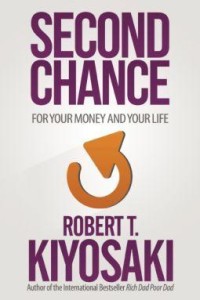Second Chance begins with a story of a successful employee, who now must work multiple jobs to make ends meet. Loaded in debt, no house, and no job seems to be the audience of this book. Robert Kiyosaki’s answer to the recent recession and people who lost jobs is for everyone to create their own jobs and become a businessperson.
The author seems to pin all the blame for loss of jobs and being broke on their inability to understand the world of finance and how money works. His answer to all the ills of current economy is to introduce financial training in the school system, which he reiterates throughout the book.
Second Chance: for Your Money, Your Life and Our World
Author: Robert T. Kiyosaki Pages: 400 pages Publisher: Plata Publishing (January 6, 2015) ISBN-10: 1612680461, 978-1612680460
In the first three-fourth, Second Chance mostly tells you what you have been hearing for the last seven years on how the 2007 economic crisis precipitated. The author digs into various economic policies and decisions by successive governments that helped big businesses by punishing the middle class and the poor. Although there is some truth in these claims, I don’t think the book’s subject warrants this much space on how the government made bad decisions.
For people who do not understand the basics of financial systems, the author does explain how the banking system works at a high level. You will also get a very good understanding of difference between an asset and a liability. The author’s writing style is simple and easy to understand, however, a lot of information is repetitive. Moreover, the author keeps referring to his other books and how he had said this and said that. I believe that someone like Robert Kiyosaki does not need to persuade readers about his credibility as a speaker. This constant repetition starts to look like a cross sale after some time.
By the time you reach the third part of Second Chance, you surely start to wonder if the author intends to give any specific information on managing money and finances to the readers. Understanding the past is important and knowing the present is crucial, but I think book takes a lot of time to reach the main subject of the book
The third part of the book forms the core of the book where the author talks about making wise investment decisions. The recent economic crisis has put a lot of emphasis on debt and how debt is bad. In The Opposite of “Get Out of Debt”, the author explains that not all debt is bad. Debt can help you expand and grow, if used correctly. He explains this with an example of real-estate investment scenario – not for staying, but to generate a steady cash flow.
Most of the book is written in a question-answer style, so if you don’t like reading a Socratic dialogue, you may find reading it a bit unnerving.
In Summary, I will say that you should read Second Chance if you have absolutely no idea about investing money and if you are not sure if your car goes into the asset column or the liability column. There is some very good advice, but the book seems more of an argument for why you need to understand investment rather than actual investment advice, which comes a bit too late in the book.